International Human Resource Management Essay: Culture's Role
VerifiedAdded on 2022/09/14
|8
|2043
|17
Essay
AI Summary
This essay critically evaluates the statement that "culture has become less important as the world becomes more global." It argues that culture remains vital, especially in the context of international business. The essay defines culture and discusses the impact of globalization, emphasizing the need for cultural sensitivity in multinational organizations. It examines how culture influences communication, consumer behavior, and business operations. The paper uses the competing values framework to analyze how multinational organizations address cultural challenges and opportunities, focusing on dimensions such as flexibility, internal/external orientation, and various change strategies. It concludes that while globalization facilitates cultural exchange, it also underscores the significance of understanding and adapting to diverse cultural contexts for effective international human resource management.
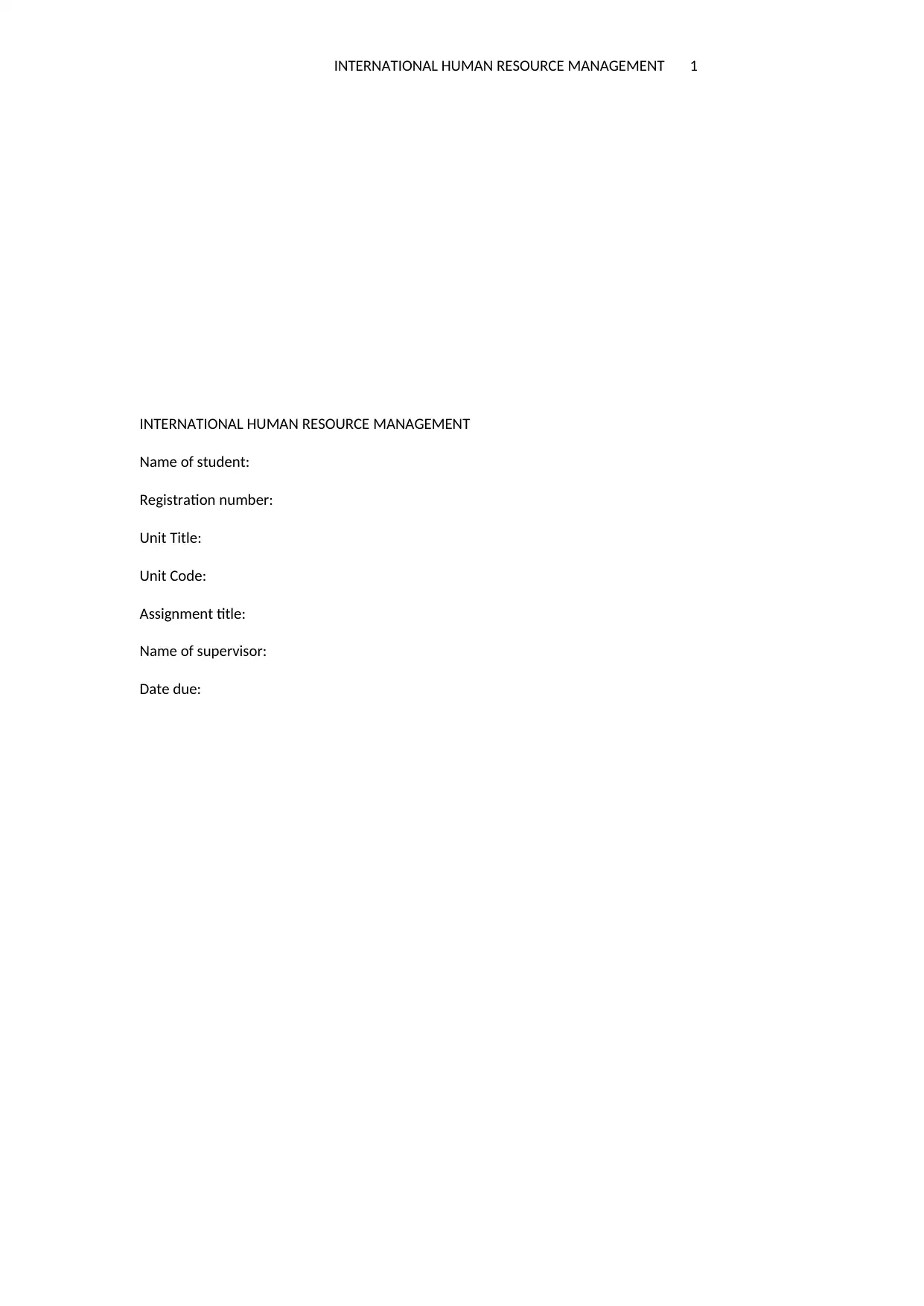
INTERNATIONAL HUMAN RESOURCE MANAGEMENT 1
INTERNATIONAL HUMAN RESOURCE MANAGEMENT
Name of student:
Registration number:
Unit Title:
Unit Code:
Assignment title:
Name of supervisor:
Date due:
INTERNATIONAL HUMAN RESOURCE MANAGEMENT
Name of student:
Registration number:
Unit Title:
Unit Code:
Assignment title:
Name of supervisor:
Date due:
Paraphrase This Document
Need a fresh take? Get an instant paraphrase of this document with our AI Paraphraser
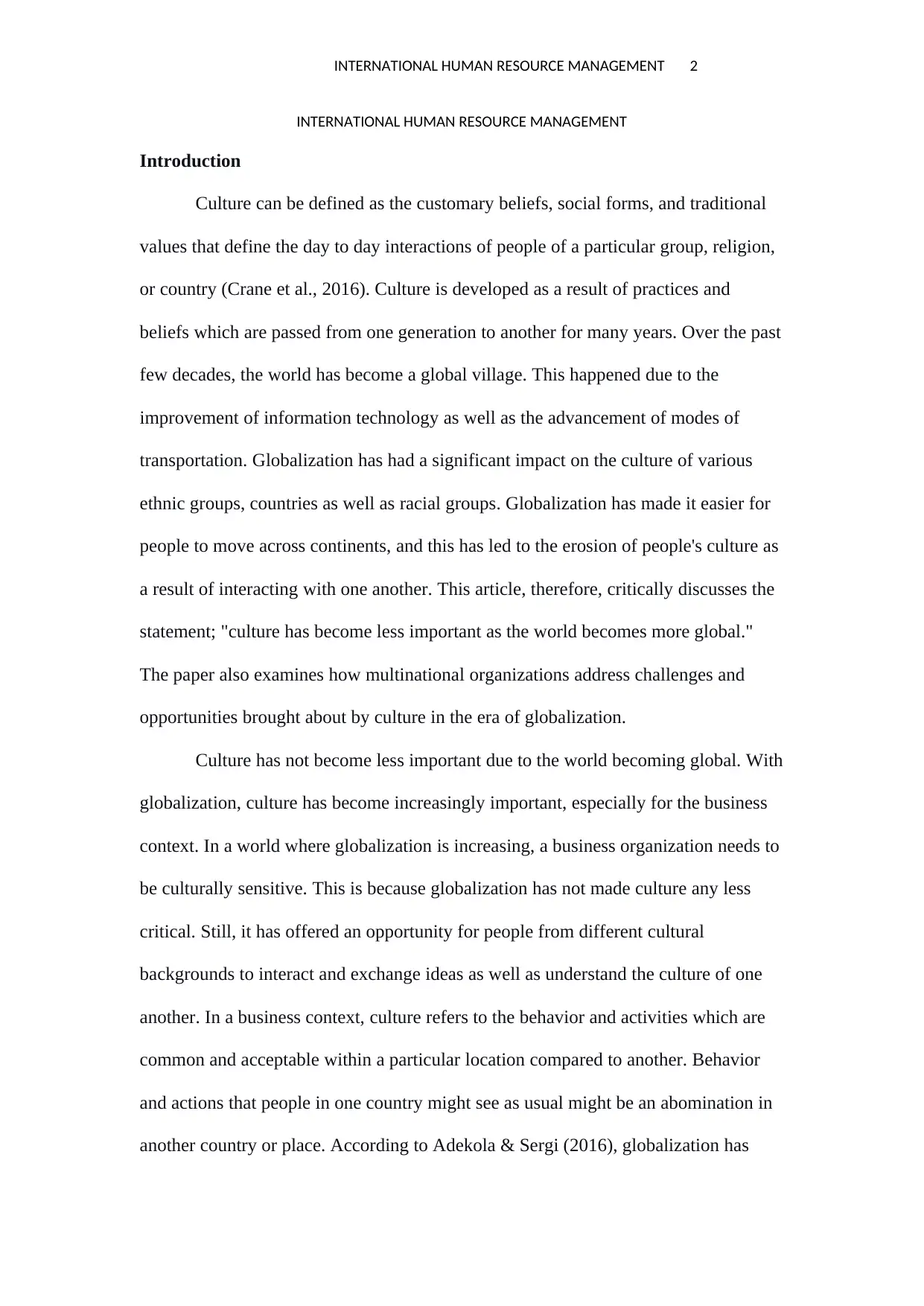
INTERNATIONAL HUMAN RESOURCE MANAGEMENT 2
INTERNATIONAL HUMAN RESOURCE MANAGEMENT
Introduction
Culture can be defined as the customary beliefs, social forms, and traditional
values that define the day to day interactions of people of a particular group, religion,
or country (Crane et al., 2016). Culture is developed as a result of practices and
beliefs which are passed from one generation to another for many years. Over the past
few decades, the world has become a global village. This happened due to the
improvement of information technology as well as the advancement of modes of
transportation. Globalization has had a significant impact on the culture of various
ethnic groups, countries as well as racial groups. Globalization has made it easier for
people to move across continents, and this has led to the erosion of people's culture as
a result of interacting with one another. This article, therefore, critically discusses the
statement; "culture has become less important as the world becomes more global."
The paper also examines how multinational organizations address challenges and
opportunities brought about by culture in the era of globalization.
Culture has not become less important due to the world becoming global. With
globalization, culture has become increasingly important, especially for the business
context. In a world where globalization is increasing, a business organization needs to
be culturally sensitive. This is because globalization has not made culture any less
critical. Still, it has offered an opportunity for people from different cultural
backgrounds to interact and exchange ideas as well as understand the culture of one
another. In a business context, culture refers to the behavior and activities which are
common and acceptable within a particular location compared to another. Behavior
and actions that people in one country might see as usual might be an abomination in
another country or place. According to Adekola & Sergi (2016), globalization has
INTERNATIONAL HUMAN RESOURCE MANAGEMENT
Introduction
Culture can be defined as the customary beliefs, social forms, and traditional
values that define the day to day interactions of people of a particular group, religion,
or country (Crane et al., 2016). Culture is developed as a result of practices and
beliefs which are passed from one generation to another for many years. Over the past
few decades, the world has become a global village. This happened due to the
improvement of information technology as well as the advancement of modes of
transportation. Globalization has had a significant impact on the culture of various
ethnic groups, countries as well as racial groups. Globalization has made it easier for
people to move across continents, and this has led to the erosion of people's culture as
a result of interacting with one another. This article, therefore, critically discusses the
statement; "culture has become less important as the world becomes more global."
The paper also examines how multinational organizations address challenges and
opportunities brought about by culture in the era of globalization.
Culture has not become less important due to the world becoming global. With
globalization, culture has become increasingly important, especially for the business
context. In a world where globalization is increasing, a business organization needs to
be culturally sensitive. This is because globalization has not made culture any less
critical. Still, it has offered an opportunity for people from different cultural
backgrounds to interact and exchange ideas as well as understand the culture of one
another. In a business context, culture refers to the behavior and activities which are
common and acceptable within a particular location compared to another. Behavior
and actions that people in one country might see as usual might be an abomination in
another country or place. According to Adekola & Sergi (2016), globalization has
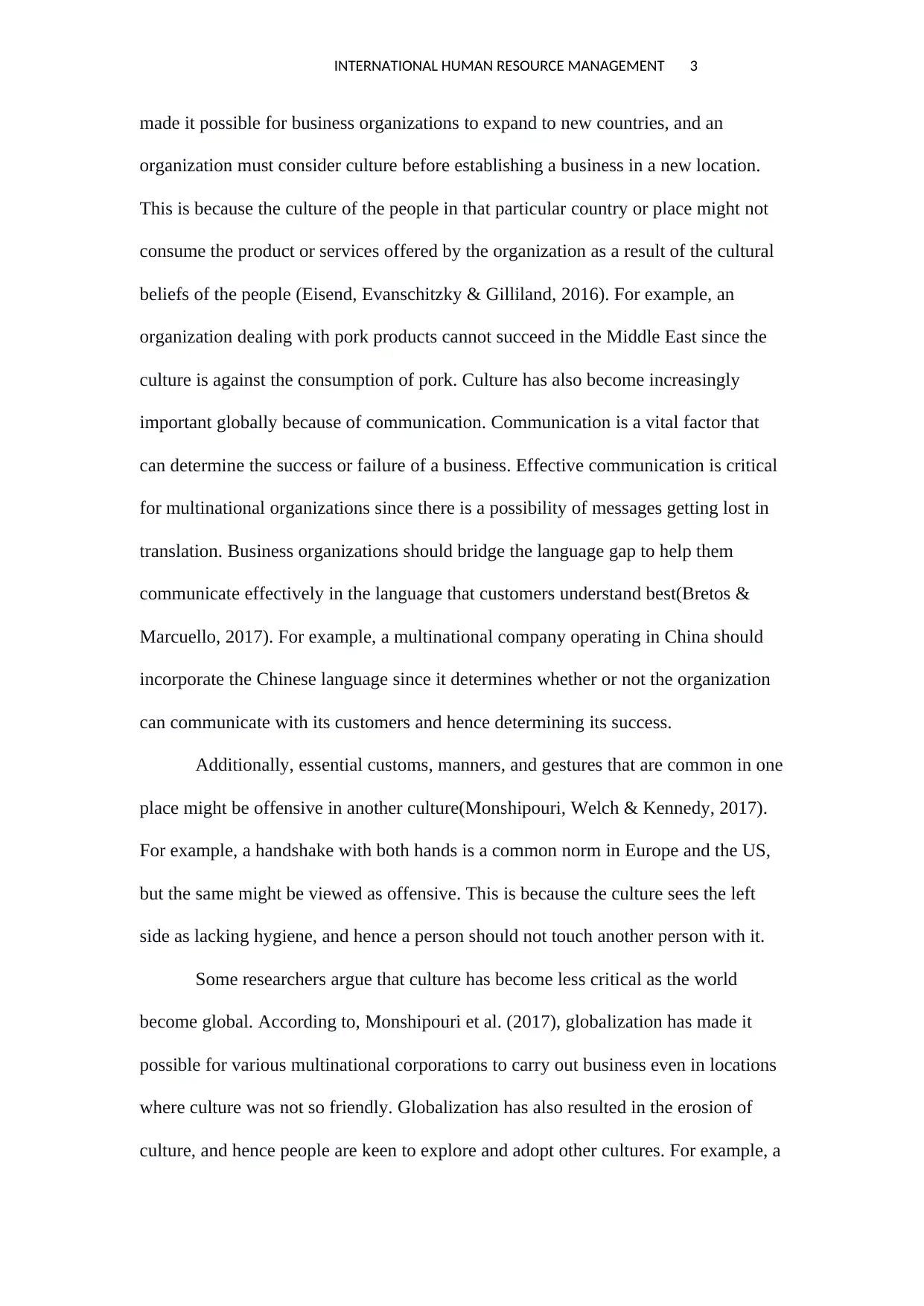
INTERNATIONAL HUMAN RESOURCE MANAGEMENT 3
made it possible for business organizations to expand to new countries, and an
organization must consider culture before establishing a business in a new location.
This is because the culture of the people in that particular country or place might not
consume the product or services offered by the organization as a result of the cultural
beliefs of the people (Eisend, Evanschitzky & Gilliland, 2016). For example, an
organization dealing with pork products cannot succeed in the Middle East since the
culture is against the consumption of pork. Culture has also become increasingly
important globally because of communication. Communication is a vital factor that
can determine the success or failure of a business. Effective communication is critical
for multinational organizations since there is a possibility of messages getting lost in
translation. Business organizations should bridge the language gap to help them
communicate effectively in the language that customers understand best(Bretos &
Marcuello, 2017). For example, a multinational company operating in China should
incorporate the Chinese language since it determines whether or not the organization
can communicate with its customers and hence determining its success.
Additionally, essential customs, manners, and gestures that are common in one
place might be offensive in another culture(Monshipouri, Welch & Kennedy, 2017).
For example, a handshake with both hands is a common norm in Europe and the US,
but the same might be viewed as offensive. This is because the culture sees the left
side as lacking hygiene, and hence a person should not touch another person with it.
Some researchers argue that culture has become less critical as the world
become global. According to, Monshipouri et al. (2017), globalization has made it
possible for various multinational corporations to carry out business even in locations
where culture was not so friendly. Globalization has also resulted in the erosion of
culture, and hence people are keen to explore and adopt other cultures. For example, a
made it possible for business organizations to expand to new countries, and an
organization must consider culture before establishing a business in a new location.
This is because the culture of the people in that particular country or place might not
consume the product or services offered by the organization as a result of the cultural
beliefs of the people (Eisend, Evanschitzky & Gilliland, 2016). For example, an
organization dealing with pork products cannot succeed in the Middle East since the
culture is against the consumption of pork. Culture has also become increasingly
important globally because of communication. Communication is a vital factor that
can determine the success or failure of a business. Effective communication is critical
for multinational organizations since there is a possibility of messages getting lost in
translation. Business organizations should bridge the language gap to help them
communicate effectively in the language that customers understand best(Bretos &
Marcuello, 2017). For example, a multinational company operating in China should
incorporate the Chinese language since it determines whether or not the organization
can communicate with its customers and hence determining its success.
Additionally, essential customs, manners, and gestures that are common in one
place might be offensive in another culture(Monshipouri, Welch & Kennedy, 2017).
For example, a handshake with both hands is a common norm in Europe and the US,
but the same might be viewed as offensive. This is because the culture sees the left
side as lacking hygiene, and hence a person should not touch another person with it.
Some researchers argue that culture has become less critical as the world
become global. According to, Monshipouri et al. (2017), globalization has made it
possible for various multinational corporations to carry out business even in locations
where culture was not so friendly. Globalization has also resulted in the erosion of
culture, and hence people are keen to explore and adopt other cultures. For example, a
⊘ This is a preview!⊘
Do you want full access?
Subscribe today to unlock all pages.

Trusted by 1+ million students worldwide
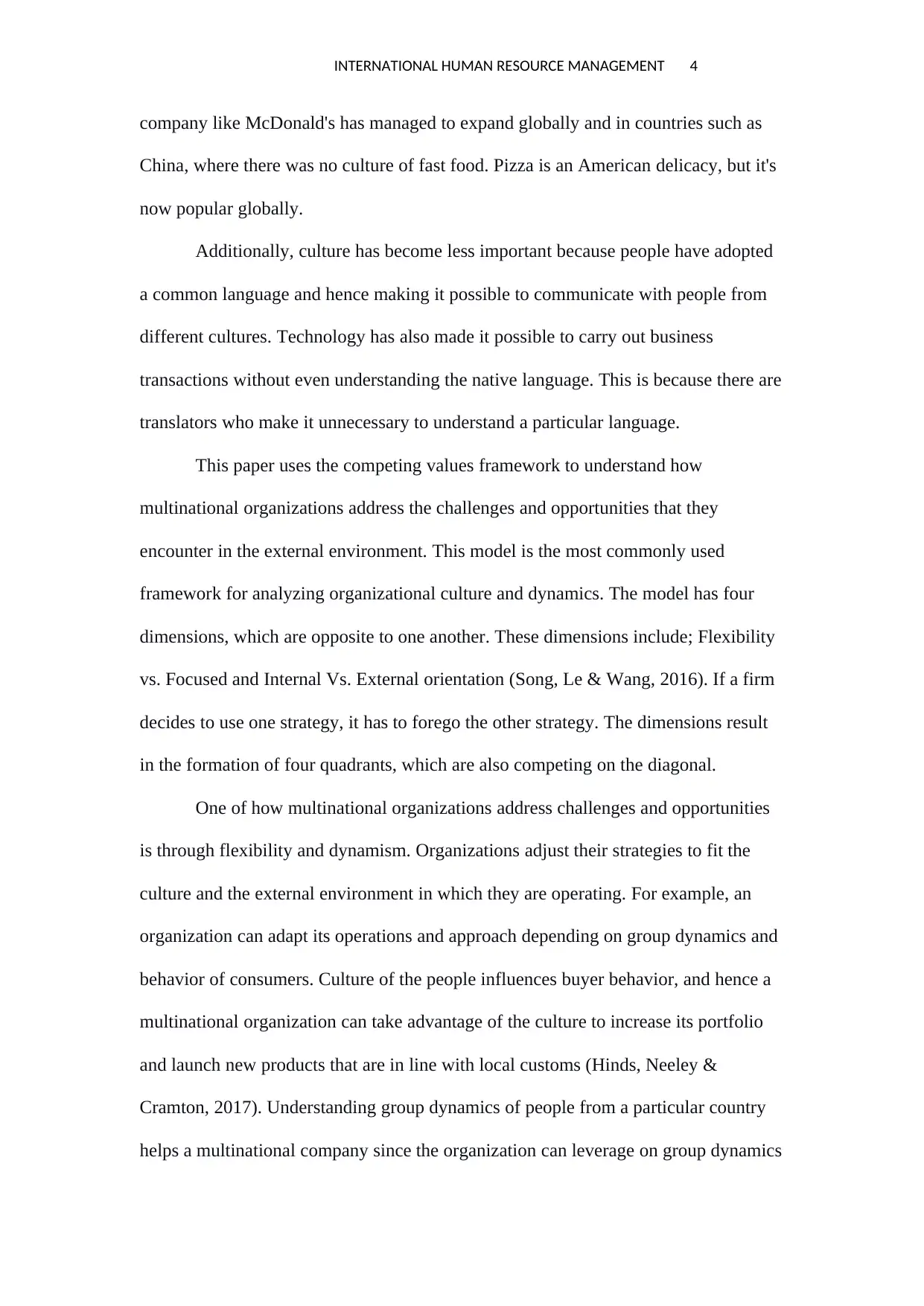
INTERNATIONAL HUMAN RESOURCE MANAGEMENT 4
company like McDonald's has managed to expand globally and in countries such as
China, where there was no culture of fast food. Pizza is an American delicacy, but it's
now popular globally.
Additionally, culture has become less important because people have adopted
a common language and hence making it possible to communicate with people from
different cultures. Technology has also made it possible to carry out business
transactions without even understanding the native language. This is because there are
translators who make it unnecessary to understand a particular language.
This paper uses the competing values framework to understand how
multinational organizations address the challenges and opportunities that they
encounter in the external environment. This model is the most commonly used
framework for analyzing organizational culture and dynamics. The model has four
dimensions, which are opposite to one another. These dimensions include; Flexibility
vs. Focused and Internal Vs. External orientation (Song, Le & Wang, 2016). If a firm
decides to use one strategy, it has to forego the other strategy. The dimensions result
in the formation of four quadrants, which are also competing on the diagonal.
One of how multinational organizations address challenges and opportunities
is through flexibility and dynamism. Organizations adjust their strategies to fit the
culture and the external environment in which they are operating. For example, an
organization can adapt its operations and approach depending on group dynamics and
behavior of consumers. Culture of the people influences buyer behavior, and hence a
multinational organization can take advantage of the culture to increase its portfolio
and launch new products that are in line with local customs (Hinds, Neeley &
Cramton, 2017). Understanding group dynamics of people from a particular country
helps a multinational company since the organization can leverage on group dynamics
company like McDonald's has managed to expand globally and in countries such as
China, where there was no culture of fast food. Pizza is an American delicacy, but it's
now popular globally.
Additionally, culture has become less important because people have adopted
a common language and hence making it possible to communicate with people from
different cultures. Technology has also made it possible to carry out business
transactions without even understanding the native language. This is because there are
translators who make it unnecessary to understand a particular language.
This paper uses the competing values framework to understand how
multinational organizations address the challenges and opportunities that they
encounter in the external environment. This model is the most commonly used
framework for analyzing organizational culture and dynamics. The model has four
dimensions, which are opposite to one another. These dimensions include; Flexibility
vs. Focused and Internal Vs. External orientation (Song, Le & Wang, 2016). If a firm
decides to use one strategy, it has to forego the other strategy. The dimensions result
in the formation of four quadrants, which are also competing on the diagonal.
One of how multinational organizations address challenges and opportunities
is through flexibility and dynamism. Organizations adjust their strategies to fit the
culture and the external environment in which they are operating. For example, an
organization can adapt its operations and approach depending on group dynamics and
behavior of consumers. Culture of the people influences buyer behavior, and hence a
multinational organization can take advantage of the culture to increase its portfolio
and launch new products that are in line with local customs (Hinds, Neeley &
Cramton, 2017). Understanding group dynamics of people from a particular country
helps a multinational company since the organization can leverage on group dynamics
Paraphrase This Document
Need a fresh take? Get an instant paraphrase of this document with our AI Paraphraser
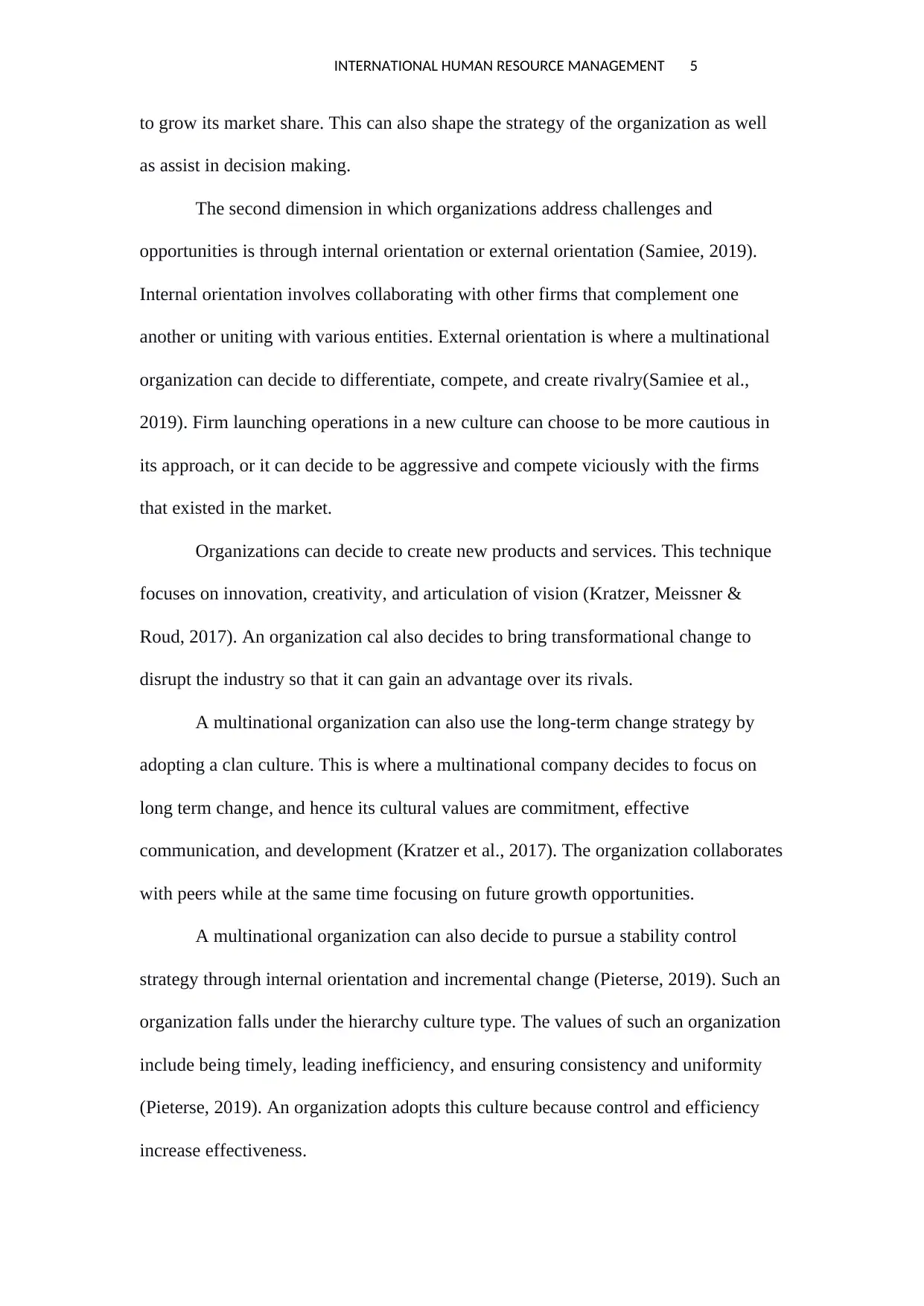
INTERNATIONAL HUMAN RESOURCE MANAGEMENT 5
to grow its market share. This can also shape the strategy of the organization as well
as assist in decision making.
The second dimension in which organizations address challenges and
opportunities is through internal orientation or external orientation (Samiee, 2019).
Internal orientation involves collaborating with other firms that complement one
another or uniting with various entities. External orientation is where a multinational
organization can decide to differentiate, compete, and create rivalry(Samiee et al.,
2019). Firm launching operations in a new culture can choose to be more cautious in
its approach, or it can decide to be aggressive and compete viciously with the firms
that existed in the market.
Organizations can decide to create new products and services. This technique
focuses on innovation, creativity, and articulation of vision (Kratzer, Meissner &
Roud, 2017). An organization cal also decides to bring transformational change to
disrupt the industry so that it can gain an advantage over its rivals.
A multinational organization can also use the long-term change strategy by
adopting a clan culture. This is where a multinational company decides to focus on
long term change, and hence its cultural values are commitment, effective
communication, and development (Kratzer et al., 2017). The organization collaborates
with peers while at the same time focusing on future growth opportunities.
A multinational organization can also decide to pursue a stability control
strategy through internal orientation and incremental change (Pieterse, 2019). Such an
organization falls under the hierarchy culture type. The values of such an organization
include being timely, leading inefficiency, and ensuring consistency and uniformity
(Pieterse, 2019). An organization adopts this culture because control and efficiency
increase effectiveness.
to grow its market share. This can also shape the strategy of the organization as well
as assist in decision making.
The second dimension in which organizations address challenges and
opportunities is through internal orientation or external orientation (Samiee, 2019).
Internal orientation involves collaborating with other firms that complement one
another or uniting with various entities. External orientation is where a multinational
organization can decide to differentiate, compete, and create rivalry(Samiee et al.,
2019). Firm launching operations in a new culture can choose to be more cautious in
its approach, or it can decide to be aggressive and compete viciously with the firms
that existed in the market.
Organizations can decide to create new products and services. This technique
focuses on innovation, creativity, and articulation of vision (Kratzer, Meissner &
Roud, 2017). An organization cal also decides to bring transformational change to
disrupt the industry so that it can gain an advantage over its rivals.
A multinational organization can also use the long-term change strategy by
adopting a clan culture. This is where a multinational company decides to focus on
long term change, and hence its cultural values are commitment, effective
communication, and development (Kratzer et al., 2017). The organization collaborates
with peers while at the same time focusing on future growth opportunities.
A multinational organization can also decide to pursue a stability control
strategy through internal orientation and incremental change (Pieterse, 2019). Such an
organization falls under the hierarchy culture type. The values of such an organization
include being timely, leading inefficiency, and ensuring consistency and uniformity
(Pieterse, 2019). An organization adopts this culture because control and efficiency
increase effectiveness.
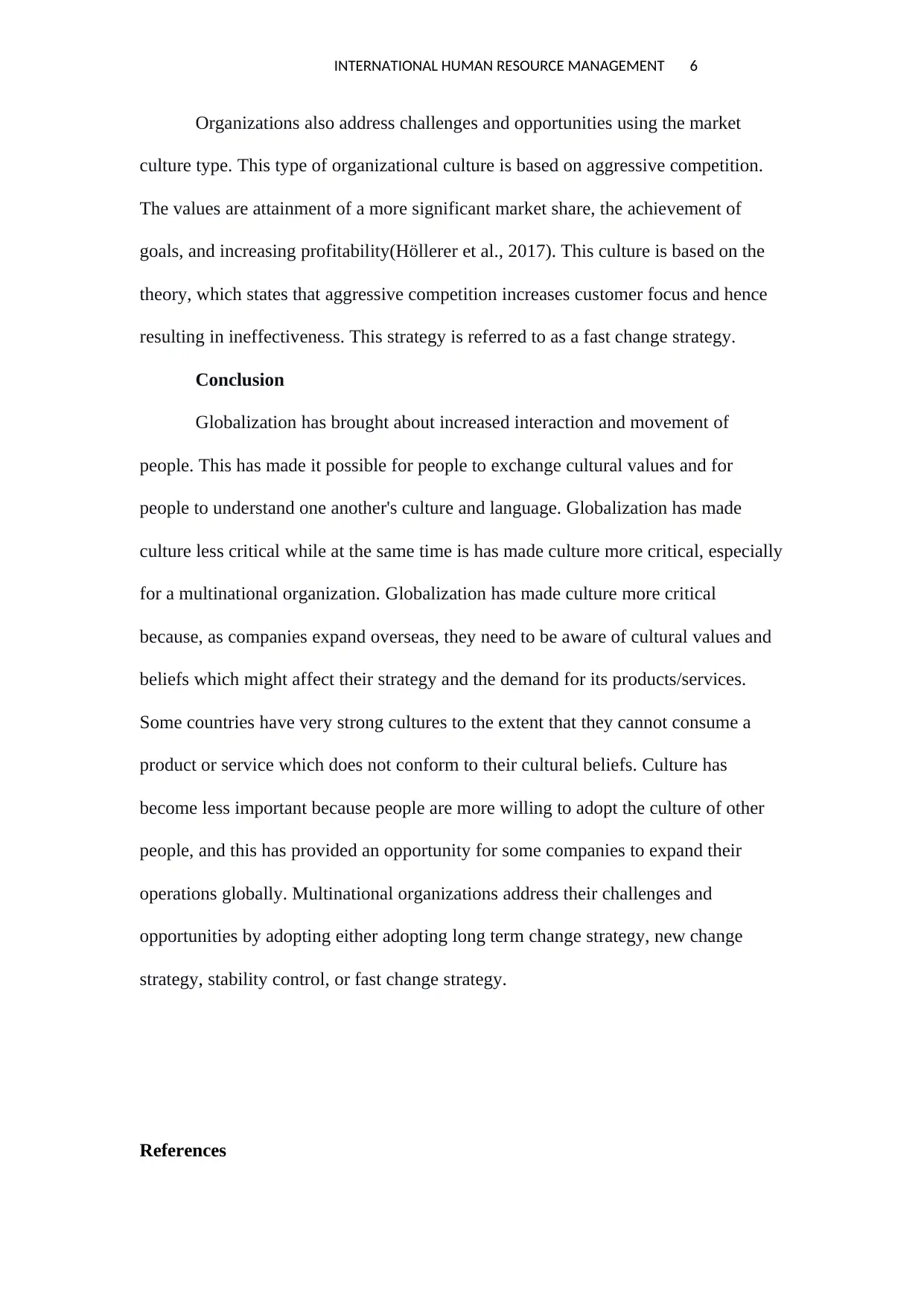
INTERNATIONAL HUMAN RESOURCE MANAGEMENT 6
Organizations also address challenges and opportunities using the market
culture type. This type of organizational culture is based on aggressive competition.
The values are attainment of a more significant market share, the achievement of
goals, and increasing profitability(Höllerer et al., 2017). This culture is based on the
theory, which states that aggressive competition increases customer focus and hence
resulting in ineffectiveness. This strategy is referred to as a fast change strategy.
Conclusion
Globalization has brought about increased interaction and movement of
people. This has made it possible for people to exchange cultural values and for
people to understand one another's culture and language. Globalization has made
culture less critical while at the same time is has made culture more critical, especially
for a multinational organization. Globalization has made culture more critical
because, as companies expand overseas, they need to be aware of cultural values and
beliefs which might affect their strategy and the demand for its products/services.
Some countries have very strong cultures to the extent that they cannot consume a
product or service which does not conform to their cultural beliefs. Culture has
become less important because people are more willing to adopt the culture of other
people, and this has provided an opportunity for some companies to expand their
operations globally. Multinational organizations address their challenges and
opportunities by adopting either adopting long term change strategy, new change
strategy, stability control, or fast change strategy.
References
Organizations also address challenges and opportunities using the market
culture type. This type of organizational culture is based on aggressive competition.
The values are attainment of a more significant market share, the achievement of
goals, and increasing profitability(Höllerer et al., 2017). This culture is based on the
theory, which states that aggressive competition increases customer focus and hence
resulting in ineffectiveness. This strategy is referred to as a fast change strategy.
Conclusion
Globalization has brought about increased interaction and movement of
people. This has made it possible for people to exchange cultural values and for
people to understand one another's culture and language. Globalization has made
culture less critical while at the same time is has made culture more critical, especially
for a multinational organization. Globalization has made culture more critical
because, as companies expand overseas, they need to be aware of cultural values and
beliefs which might affect their strategy and the demand for its products/services.
Some countries have very strong cultures to the extent that they cannot consume a
product or service which does not conform to their cultural beliefs. Culture has
become less important because people are more willing to adopt the culture of other
people, and this has provided an opportunity for some companies to expand their
operations globally. Multinational organizations address their challenges and
opportunities by adopting either adopting long term change strategy, new change
strategy, stability control, or fast change strategy.
References
⊘ This is a preview!⊘
Do you want full access?
Subscribe today to unlock all pages.

Trusted by 1+ million students worldwide
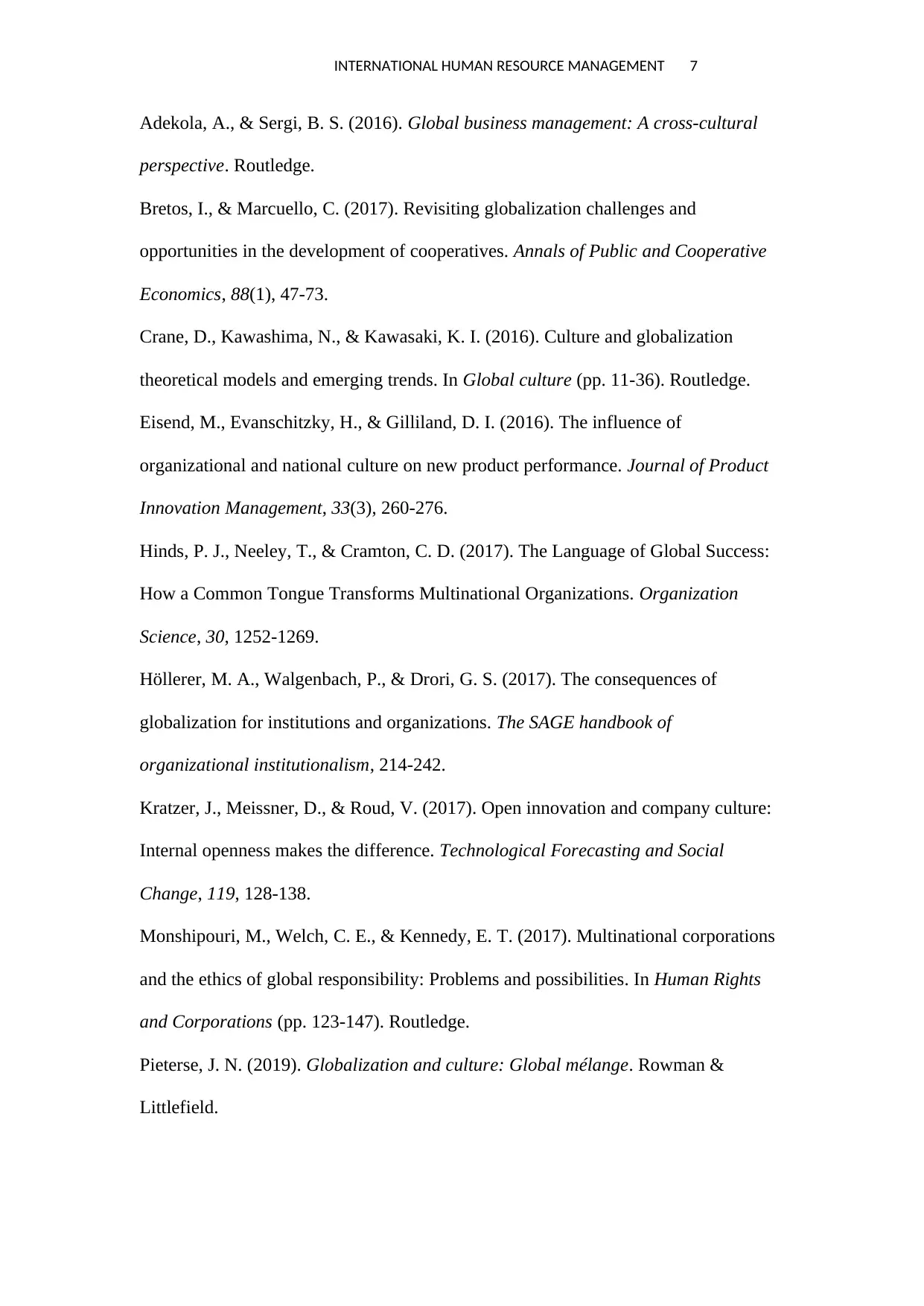
INTERNATIONAL HUMAN RESOURCE MANAGEMENT 7
Adekola, A., & Sergi, B. S. (2016). Global business management: A cross-cultural
perspective. Routledge.
Bretos, I., & Marcuello, C. (2017). Revisiting globalization challenges and
opportunities in the development of cooperatives. Annals of Public and Cooperative
Economics, 88(1), 47-73.
Crane, D., Kawashima, N., & Kawasaki, K. I. (2016). Culture and globalization
theoretical models and emerging trends. In Global culture (pp. 11-36). Routledge.
Eisend, M., Evanschitzky, H., & Gilliland, D. I. (2016). The influence of
organizational and national culture on new product performance. Journal of Product
Innovation Management, 33(3), 260-276.
Hinds, P. J., Neeley, T., & Cramton, C. D. (2017). The Language of Global Success:
How a Common Tongue Transforms Multinational Organizations. Organization
Science, 30, 1252-1269.
Höllerer, M. A., Walgenbach, P., & Drori, G. S. (2017). The consequences of
globalization for institutions and organizations. The SAGE handbook of
organizational institutionalism, 214-242.
Kratzer, J., Meissner, D., & Roud, V. (2017). Open innovation and company culture:
Internal openness makes the difference. Technological Forecasting and Social
Change, 119, 128-138.
Monshipouri, M., Welch, C. E., & Kennedy, E. T. (2017). Multinational corporations
and the ethics of global responsibility: Problems and possibilities. In Human Rights
and Corporations (pp. 123-147). Routledge.
Pieterse, J. N. (2019). Globalization and culture: Global mélange. Rowman &
Littlefield.
Adekola, A., & Sergi, B. S. (2016). Global business management: A cross-cultural
perspective. Routledge.
Bretos, I., & Marcuello, C. (2017). Revisiting globalization challenges and
opportunities in the development of cooperatives. Annals of Public and Cooperative
Economics, 88(1), 47-73.
Crane, D., Kawashima, N., & Kawasaki, K. I. (2016). Culture and globalization
theoretical models and emerging trends. In Global culture (pp. 11-36). Routledge.
Eisend, M., Evanschitzky, H., & Gilliland, D. I. (2016). The influence of
organizational and national culture on new product performance. Journal of Product
Innovation Management, 33(3), 260-276.
Hinds, P. J., Neeley, T., & Cramton, C. D. (2017). The Language of Global Success:
How a Common Tongue Transforms Multinational Organizations. Organization
Science, 30, 1252-1269.
Höllerer, M. A., Walgenbach, P., & Drori, G. S. (2017). The consequences of
globalization for institutions and organizations. The SAGE handbook of
organizational institutionalism, 214-242.
Kratzer, J., Meissner, D., & Roud, V. (2017). Open innovation and company culture:
Internal openness makes the difference. Technological Forecasting and Social
Change, 119, 128-138.
Monshipouri, M., Welch, C. E., & Kennedy, E. T. (2017). Multinational corporations
and the ethics of global responsibility: Problems and possibilities. In Human Rights
and Corporations (pp. 123-147). Routledge.
Pieterse, J. N. (2019). Globalization and culture: Global mélange. Rowman &
Littlefield.
Paraphrase This Document
Need a fresh take? Get an instant paraphrase of this document with our AI Paraphraser
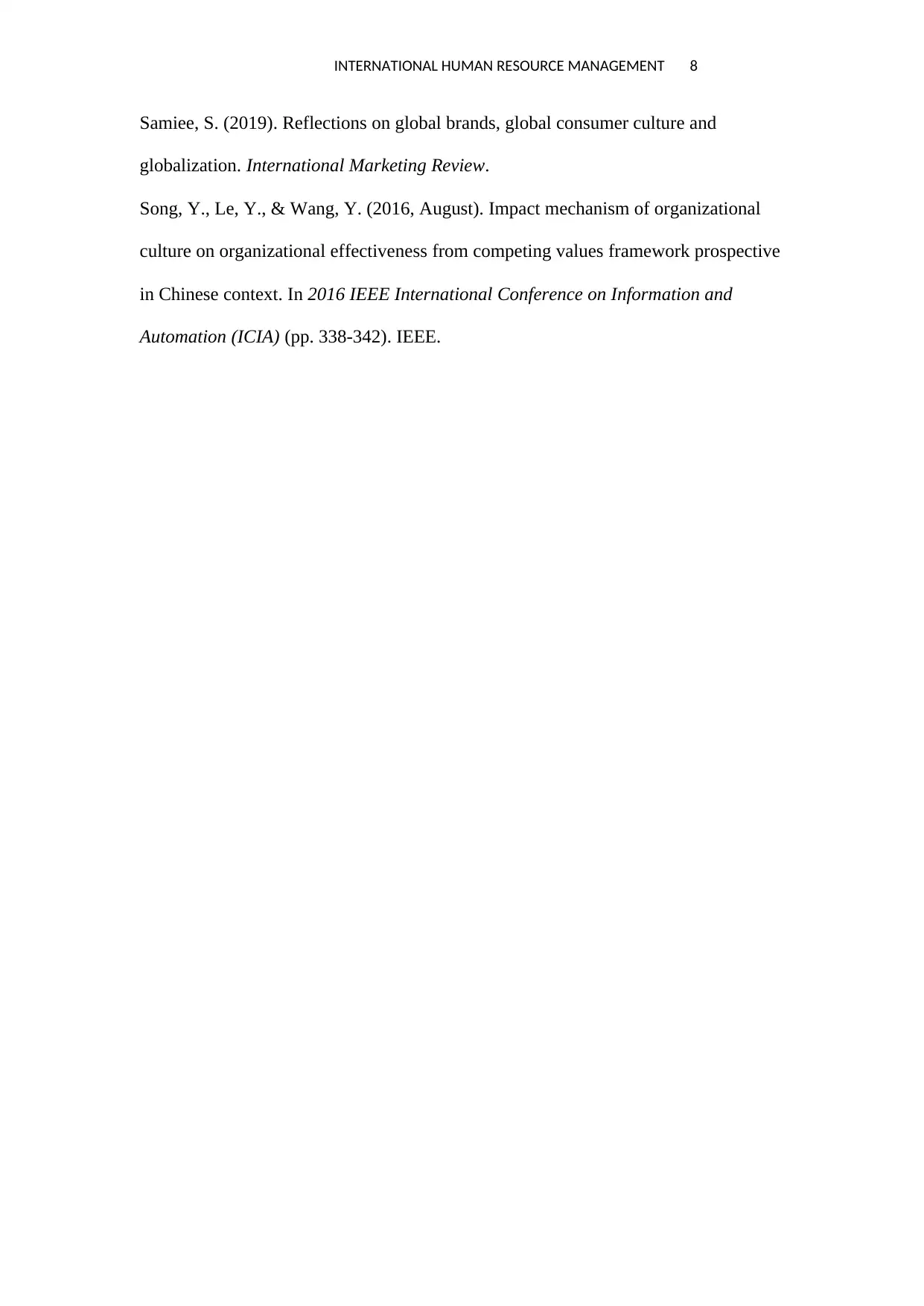
INTERNATIONAL HUMAN RESOURCE MANAGEMENT 8
Samiee, S. (2019). Reflections on global brands, global consumer culture and
globalization. International Marketing Review.
Song, Y., Le, Y., & Wang, Y. (2016, August). Impact mechanism of organizational
culture on organizational effectiveness from competing values framework prospective
in Chinese context. In 2016 IEEE International Conference on Information and
Automation (ICIA) (pp. 338-342). IEEE.
Samiee, S. (2019). Reflections on global brands, global consumer culture and
globalization. International Marketing Review.
Song, Y., Le, Y., & Wang, Y. (2016, August). Impact mechanism of organizational
culture on organizational effectiveness from competing values framework prospective
in Chinese context. In 2016 IEEE International Conference on Information and
Automation (ICIA) (pp. 338-342). IEEE.
1 out of 8
Related Documents
Your All-in-One AI-Powered Toolkit for Academic Success.
+13062052269
info@desklib.com
Available 24*7 on WhatsApp / Email
![[object Object]](/_next/static/media/star-bottom.7253800d.svg)
Unlock your academic potential
Copyright © 2020–2025 A2Z Services. All Rights Reserved. Developed and managed by ZUCOL.





